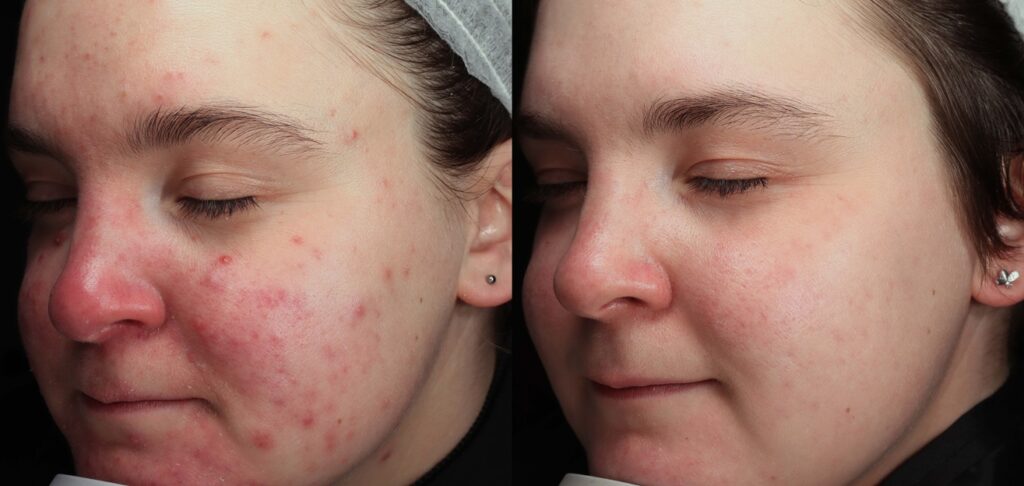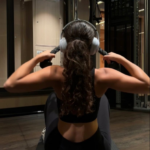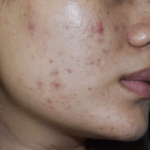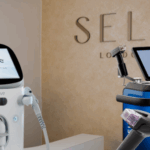
Why Adult Female Acne Is Misunderstood and What the Newest Laser Science Is Teaching Us. Explained by London Dermatologist, Dr Anjali Mahto
It is a familiar story. A woman in her thirties or forties, often highly functioning, health-conscious, and well informed, finds herself caught in a relentless cycle of breakouts. She may have sailed through her teenage years with clear skin, only to find acne erupting later in life with no clear trigger. Or perhaps she has struggled with acne since adolescence, enduring years of treatments, only to see it resurface after a period of remission. Adult female acne is often misunderstood by patients, peers, and even practitioners. At Self London, we believe it deserves a far more intelligent and nuanced approach.
Most public discourse still treats acne as a problem of adolescence. The marketing of acne products remains youth-focused. NHS pathways remain limited, with adult women often dismissed or steered toward the contraceptive pill or antibiotics as first-line management. Within aesthetics, acne remains underrepresented, seen as something separate from the more visible concerns of ageing, volume loss, or pigmentation. But the reality is that acne is a complex, chronic condition that affects a significant number of women well into adulthood. According to recent epidemiological data, up to 54% of women over the age of 25 report some form of acne, with a measurable impact on psychological wellbeing, professional confidence, and long-term skin quality.
The causes of adult acne are multifactorial. Hormones play a role, but so too does sebum regulation, barrier dysfunction, inflammation, and sometimes stress-induced upregulation of androgens. At Self London, we routinely see women with normal hormonal bloods but persistent breakouts along the lower face, jawline, and neck, the so-called “U-zone”, often resistant to conventional treatment. Many of these women have tried multiple courses of prescription medication. Some have been on and off isotretinoin. Others are wary of systemic drugs, whether due to side effects, mental health history, or fertility planning. They are not looking for quick fixes. They are looking for long-term remission.

This is where AviClear, a 1726 nm laser cleared by the FDA for the treatment of mild to severe acne, becomes relevant. Unlike traditional acne treatments that target surface inflammation or hormonal pathways, AviClear works by selectively heating the sebaceous glands. These glands are central to the pathogenesis of acne; overproduction of sebum creates an ideal environment for bacterial proliferation and comedone formation. What sets the 1726 nm wavelength apart is its specificity: it has a significantly higher absorption rate in sebum than in water, allowing precise, targeted photothermal destruction of overactive sebaceous glands while sparing surrounding tissue.
The science of selective photothermolysis (targeting specific skin structures based on how they absorb light) is well established, but until now, most devices used in acne treatment (such as 1450 nm lasers or broadband light) offered only partial or temporary benefit. The introduction of a laser wavelength with sebum as its primary target changes the equation. In both early clinical trials and real-world settings, AviClear has demonstrated durable reductions in inflammatory lesion counts with effects lasting many months after the final treatment session. A pivotal open-label study published in 2022 showed that 80% of patients were rated as “clear” or “almost clear” at 12 months following a course of three sessions, spaced one month apart. At Self London, our internal audit echoes these outcomes, with high completion rates and significant subjective improvement reported across all Fitzpatrick skin types.
What also makes AviClear particularly suitable for adult women is its safety profile. There is no downtime beyond transient redness, no systemic risk, and no contraindication for those planning pregnancy or managing hormonal fluctuations. For patients who have exhausted oral options, or who wish to avoid them altogether, it offers something genuinely new: a device-based pathway to clearer skin, grounded in the biology of sebaceous gland regulation.
Yet despite the innovation, most dermatology conferences and UK acne guidelines continue to exclude meaningful discussion of energy-based devices. In part, this reflects an understandable bias towards systemic treatments, the evidence base for which remains larger due to pharmaceutical funding and long-term use. But it also reflects a conservatism within the specialty, where lasers are still often viewed as aesthetic luxuries rather than serious tools in the management of chronic disease. This mindset fails patients, particularly women, who are seeking credible non-drug options and deserve more than superficial advice or product recommendations.
At Self London, we have never viewed acne as a purely cosmetic concern. For many of our patients, it is the single most distressing skin issue they face. We have built a multi-layered acne pathway, supported by consultant dermatology input and device-led intervention. Our use of AviClear is guided by close audit, pattern recognition, and experience, not sales targets. We do not treat all patients the same way. We consider the patient who flared post-isotretinoin and has been dismissed as difficult. We consider the perimenopausal woman whose skin is changing in ways no topical can fix. We consider the high-performing lawyer who has tried every skincare regime under the sun and is no longer willing to gamble on £500 facials.
We also recognise that even the best treatments are not infallible. AviClear is not a magic wand. No acne treatment is. Some patients improve rapidly; others require adjunctive support or maintenance. Some experience a flare before they get better. As clinicians, we hold space for the uncertainty. We track trends, adjust parameters, and look at the whole person in front of us. We are transparent about the fact that outcomes vary. We remain clinically cautious, because we know that acne, like all chronic diseases, is not always linear.
Acne is also an emotional condition. For women who have done everything “right”, healthy lifestyle, minimal sugar, the right products, the right supplements, the persistence of acne can feel like a personal failure. It is not. And that messaging matters. Part of what sets our clinic apart is that we understand this intimately. Our founder has lived it. Dr. Anjali Mahto has spoken openly about her own history of acne, the challenges of navigating treatment fatigue, and the emotional toll of ongoing skin issues. That lived experience runs through the way we practise. We do not patronise our patients or offer generic solutions. We build plans that make sense, based on the biology and behaviour of their skin. And when we use lasers like AviClear, it is because we believe both clinically and ethically it adds value.
In an industry increasingly shaped by performance and aesthetic trends, acne remains one of the few areas where authenticity and expertise cannot be faked. It is easy to sell skincare. It is harder to deliver long-term remission in chronic acne, especially in women with resistant or relapsing patterns. At Self London, we are not interested in short-term fixes or aggressive marketing. We are interested in offering intelligent, medically grounded care that meets women where they are, and offers them new options without empty promises.
Adult female acne is not a niche concern. It is a growing reality, influenced by stress, environment, and complex biological feedback loops. And it deserves to be treated with the same seriousness as any other skin condition. As newer technologies like AviClear evolve, we are finally seeing the emergence of options that reflect the lived experience of women who want more than another pill, another peel, or another promise.
Our message is simple. Adult acne is real. It is complex. It is not always hormonal. And for many women, lasers may now be part of the solution.





